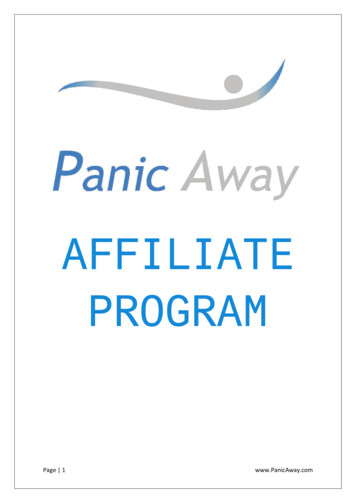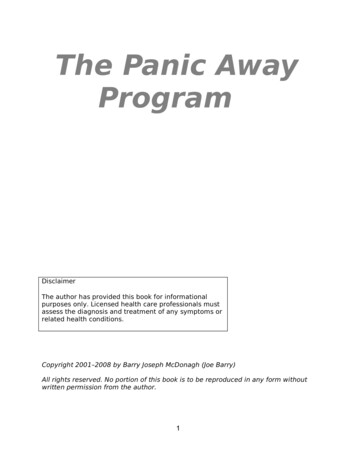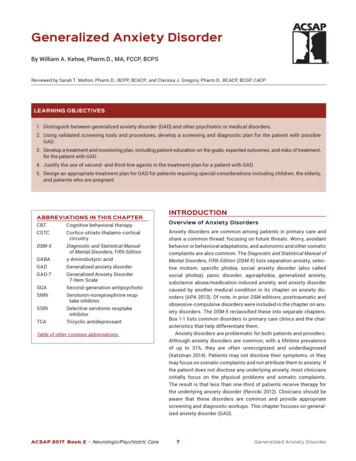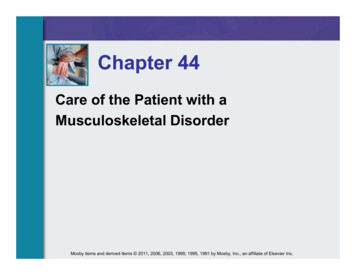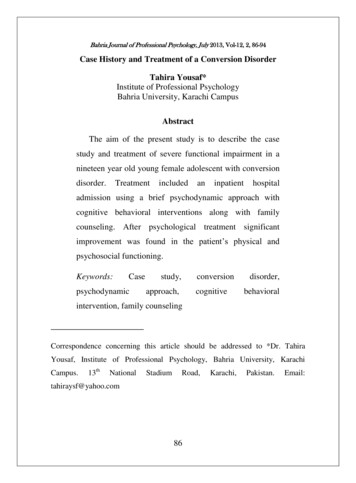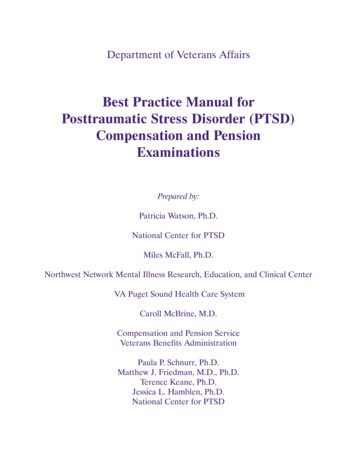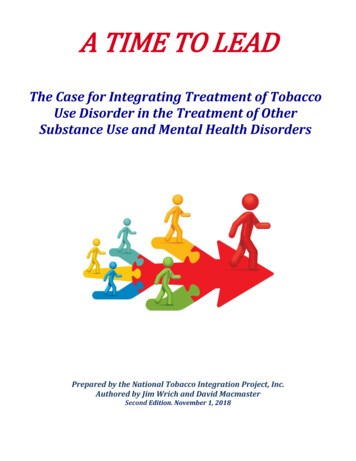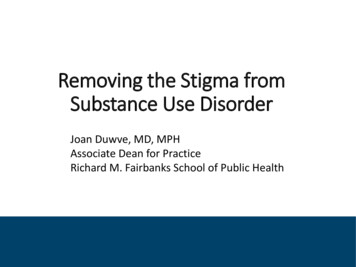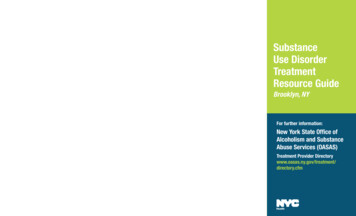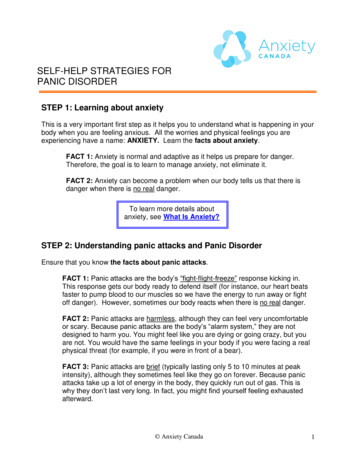
Transcription
SELF-HELP STRATEGIES FORPANIC DISORDERSTEP 1: Learning about anxietyThis is a very important first step as it helps you to understand what is happening in yourbody when you are feeling anxious. All the worries and physical feelings you areexperiencing have a name: ANXIETY. Learn the facts about anxiety.FACT 1: Anxiety is normal and adaptive as it helps us prepare for danger.Therefore, the goal is to learn to manage anxiety, not eliminate it.FACT 2: Anxiety can become a problem when our body tells us that there isdanger when there is no real danger.To learn more details aboutanxiety, see What Is Anxiety?STEP 2: Understanding panic attacks and Panic DisorderEnsure that you know the facts about panic attacks.FACT 1: Panic attacks are the body’s “fight-flight-freeze” response kicking in.This response gets our body ready to defend itself (for instance, our heart beatsfaster to pump blood to our muscles so we have the energy to run away or fightoff danger). However, sometimes our body reacts when there is no real danger.FACT 2: Panic attacks are harmless, although they can feel very uncomfortableor scary. Because panic attacks are the body’s “alarm system,” they are notdesigned to harm you. You might feel like you are dying or going crazy, but youare not. You would have the same feelings in your body if you were facing a realphysical threat (for example, if you were in front of a bear).FACT 3: Panic attacks are brief (typically lasting only 5 to 10 minutes at peakintensity), although they sometimes feel like they go on forever. Because panicattacks take up a lot of energy in the body, they quickly run out of gas. This iswhy they don’t last very long. In fact, you might find yourself feeling exhaustedafterward. Anxiety Canada1
FACT 4: Panic attacks are private experiences. Others (except those very closeto you) usually cannot tell that you are having a panic attack.Panic Disorder results from misinterpreting bodily sensations associated with the “fightflight-freeze” response as dangerous; for example, believing that an increase in yourheart rate means that you are having a heart attack. As a result, you live in fear ofadditional attacks and you start to avoid things that may trigger panic attacks. Youmight be going through life on the “lookout” for the next attack and constantly scanningyour body for panic-like sensations. Here’s one way to understand how thisapprehension about having more panic attacks keeps people “on guard.”Two hikers are going for a hike in the woods. One hiker runs into the parkranger, who warns her that a bear has been spotted in the woods. The otherhiker does not receive this warning and continues on his way enjoying anafternoon hike. If he hears a rustling in the woods, he assumes that it is asquirrel or the wind. The hiker who was told about the bear, however, is verycautious and constantly on the lookout for the bear. She becomes sensitive toanything that suggests the bear is near (for example rustling in the woods) andmight decide to avoid the woods altogether and not return to the park. This iswhat happens when you have a panic attack. Because you have been “alerted”to it, you might find yourself always on the lookout for another panic attack.This can make you feel nervous, which might lead toanother panic attack. You might even start to avoidthings that remind you of the attack.Step 3: Building your toolboxThe best way to begin managing your panic attacks is to start building a toolbox ofstrategies that you can use to help manage them. However, it is important to rememberthat panic attacks are fairly common and that they are not dangerous. Therefore, thegoal is not to eliminate panic attacks, but to learn to manage them without fear. Forpanic disorder, tools in the toolbox include: Anxiety Canada2
TOOL #1: Learning to relaxTwo relaxation strategies can be particularly helpful:1. Calm Breathing: This is a strategy that you can use to help reduce some of thephysical symptoms experienced during a panic attack. We tend to breathe faster whenwe are anxious, which can make us feel dizzy and lightheaded, which in turn can makeus even more anxious. Calm breathing involves taking slow, regular breaths throughyour nose. However, it is important to realize that the goal of calm breathing is not tostop a panic attack because it’s dangerous, but to make it a little easier to “ride out” thefeelings.For more information, see How to do Calm Breathing.KEY POINT: If you are using relaxation to help you STOP a panic attack, thisis NOT helpful. If you are using relaxation to help you turn down thevolume on the feelings (but not avoid them) this IS helpful!2. Muscle Relaxation: Another helpful strategy involves learning to relax your body.This technique involves tensing various muscles and then relaxing them, to help loweroverall tension and stress levels, which can contribute to panic attacks.For more information, see How To Do Progressive Muscle Relaxation.Note: Although it can be helpful to learn to relax, it isimportant to realize that it is not necessary to controlanxiety, because anxiety is not dangerous.TOOL #2: Realistic thinkingThe next tool involves learning to identify scary thoughts that can trigger andfuel physical feelings of panic. First, ask yourself what you are afraid will happen duringa panic attack. Examples include: “I will faint,” “It will go on forever,” “I’ll embarrassmyself,” “I’ll have a heart attack,” or “I’ll die.” To become more aware of your specificfears, try to identify your thoughts (and write them down) whenever you feel anxious orfeel an urge to avoid or escape a situation. Repeat this exercise for a week or so. Anxiety Canada3
Thoughts related to panic attacks can be grouped into two categories:1. Overestimating: This happens when we believe that something that is highlyunlikely is about to happen; for example, when we believe that we will faint or die as aresult of a panic attack. This type of thinking is usually related to physical fears (such asfainting and hurting oneself, having a heart attack, going crazy, or dying)2. Catastrophizing: This is when we imagine the worst possible thing is about tohappen and that we will not be able to cope. For example: “I’ll embarrass myself andeveryone will laugh” or “I’ll freak out and no one will help.” This type of thinking is oftenrelated to social concerns (such as embarrassing oneself).To help you figure out whether you are overestimating or catastrophizing, ask yourselfthe following questions:What would be so bad about that?What would that lead to?What would happen then?Example:What am I afraid will happen when I have a panic attack? I won’t be able tobreathe.What would happen then? I would die. (Example of OVERESTIMATING)Example:What am I afraid will happen when I have a panic attack? I’ll get very scared.What would be so bad about feeling scared? I would get so scared I would passout.What would be so bad about that? Other people would notice.What would happen then? They might laugh or think something is seriously wrongwith me. (Example of CATASTROPHIZING).Challenging overestimating: First, it is important to realize that your thoughts areguesses about what will happen, not actual facts. Next, evaluate the evidence for oragainst your thoughts. Individuals with panic disorder often confuse a possibility with aprobability (for example, just because it can happen, doesn’t mean that it likely will). Anxiety Canada4
Here are some questions to ask yourself:How many times have I had this thought during a panic attack?How many times has it actually happened?Next time I have this thought, how likely is it that it will really happen?It is helpful to realize that some of the things you fear are VERY unlikely to occur. Eventhough you have had this thought many times, it has not come true.Example:What am I afraid will happen? When I’m having a panic attack, I am afraid that I won’tbe able to breathe or that I’ll die.How many times have I had this thought when I am having a panic attack? A lot!How many times has it actually happened? Never. Even when it feels like I am goingto die, nothing bad has happened. However, what if THIS is the time it happens?How many times have I had that thought? Many times.How many times has it actually happened? Never.How likely is it that it will really happen? The chances of something bad happen areextremely small. It’s important to remind myself of that when I am having a panic attack!Challenging catastrophizing: To challenge catastrophic thinking, ask yourself toimagine the worst and then figure out how you would cope. Here are some questions toask yourself:What’s the worst that can happen?How bad is it REALLY?Is it a hassle or a horror?Will it make a difference in my life in a week or year from now?What could I do to cope if it did happen?Have I been embarrassed in the past? How did it turn out? Did it make adifference?It is important to understand that some of the things you fear are more of a hassle than ahorror, and that there are things you can do to cope with the situation. Anxiety Canada5
Example:What am I afraid will happen? I will have a panic attack at work.What would be so bad about that? I might pass out and my co-workers will notice.What’s the worst that could happen? Everyone will look at me. I would be soembarrassed I would just freeze.How bad is it really? Well, it would be very embarrassing to “lose it” at work.Is it a hassle or a horror? It wouldn’t feel very good, but I guess it’s more of ahassle than a major horror.Will it make a difference in my life in a week or year from now? In a week peoplemay still remember that I had one, but in a year from now it’s unlikely thatanyone will remember.How could I cope if it did happen? I could excuse myself and go to the bathroom.Have I been embarrassed in the past? Yes, I tripped on the stairs at work.How has that turned out? Did it make a difference? I felt uncomfortable aroundmy co-workers for a few days. It didn’t really make a difference in my life. I don’t thinkanyone remembers.So, how bad is it to embarrass myself? It doesn’t feel good, but it’s not that bad.You can challenge your worrisome thinking whenever you feel anxious or feel an urge toavoid or escape a situation. Writing it down helps!For more information on identifying and challenge scary thoughts see RealisticThinking.GET THE FACTS!!Panic attacks will NOT cause you to Faint: Fainting is caused by a sudden and significant drop in blood pressure.When you’re anxious, your blood pressure rises. So, it’s extremely unlikely thatyou will faint when you have a panic attack.Lose Control: Although it can feel like you are out of control, you are stillbehaving in ways that show you are in control when you have a panic attack Anxiety Canada6
(e.g., pulling the car over on the shoulder of the road or walking to the exit at thegrocery store).Go Crazy: Panic attacks do not cause people to go crazy. No one has evergone crazy from experiencing a panic attack.Die: You are not having a heart attack. The chest pain you experience during apanic attack is the result of muscle tension (which is part of the “fight-flightfreeze” response). You are not going to suffocate. The feeling of not gettingenough air is due to shallow breathing, but you are still getting enough air to live!TOOL #3: Making coping cardsIt can be tough to remember how to challenge scary thoughts when we areanxious. It can help to make up a “coping card” that includes realistic thoughts aboutpanic attacks (e.g., “It’s a hassle, not a horror,” “It won’t last for forever”) that you cancarry with you during the day to help manage anxiety. To make a “coping card,” use anindex card or a piece of paper, write down your realistic thoughts, and keep it with you(i.e., in your purse, wallet, or pocket). It can be helpful to read this card daily, just as areminder!TOOL #4: Facing fearsThe most important step in managing anxiety and panic is to face what youfear, which includes:1. Unpleasant body sensations associated with panic attacks2. Avoided situations, places, or activitiesFacing feared body sensations: Individuals with panic disorder are typically sensitiveto physical sensations (for example, increased heart rate, dizziness, blurred vision,chest pain). In order to overcome panic, you need to repeatedly bring on thesensations you fear so that over time those sensations no longer make youanxious. This also gives you a chance to see that your fears do not come true (forexample, you don’t pass out or die). Here is a list of exercises you can try and thevarious physical sensations they create.Try each one and rate your anxiety level from 0 (no fear/anxiety at all) to 10 (very severefear/anxiety) while doing the exercises. Identify the exercises that cause anxiety andbring on sensations that feel very similar to what you experience during a panic attack.How to do exposure to feared sensations. Start with the exercise that is the leastscary and build up to the scariest. Exercises can be broken up into smaller steps ifnecessary (e.g., start with running on the spot for 30 seconds, then 45 seconds and Anxiety Canada7
finally 1 minute). Continue the exercise until you start to experience the fearedsensations. Rate your anxiety level from 0 (no fear/anxiety at all) to 10 (very severefear/anxiety) while doing the exercises. Repeat the exercise until your anxiety drops byabout half (for example, if your initial rating is a 6, repeat the exercise until youexperience a 3). Focus on one exercise at a time. Once you experience very littleanxiety when completing that exercise (on several different occasions), move onto thenext one. Use the Facing Fears Form (see Facing Your Fears – Exposure) to helptrack changes in your anxiety when completing the exercises.Remember: The goal is to let yourself feel the feelings - Don’t fight them!These sensations are NOT dangerous. In fact, before you started havingpanic attacks, you may have even sought
Ensure that you know the facts about panic attacks. FACT 1: Panic attacks are the body’s “fight-flight-freeze” response kicking in. This response gets our body ready

